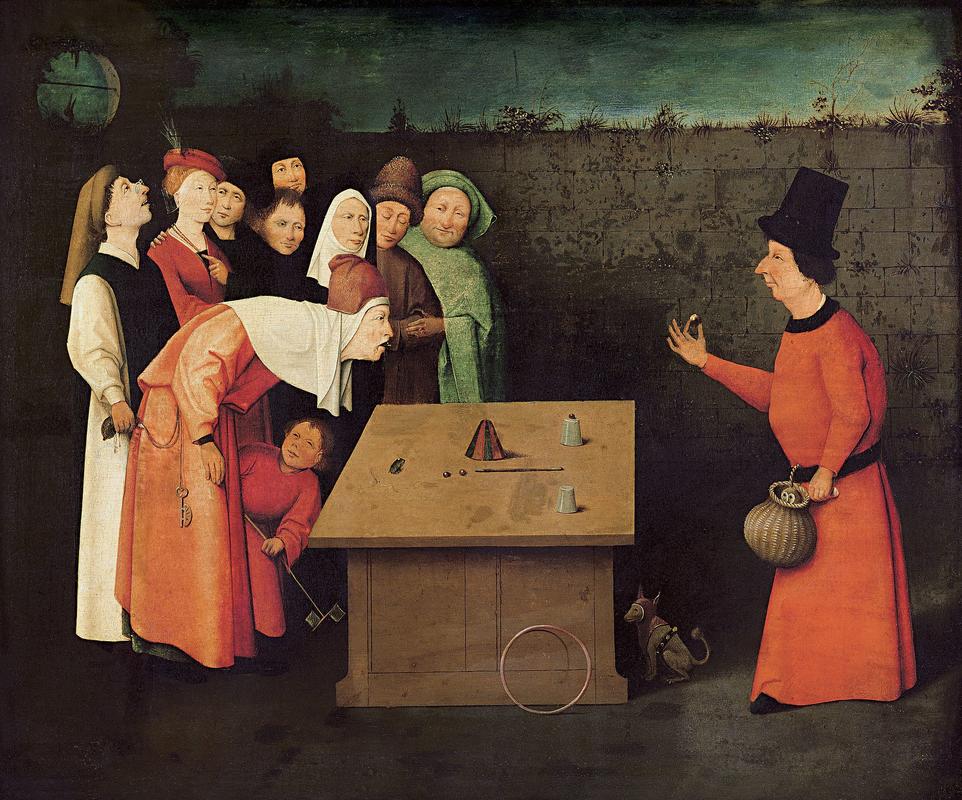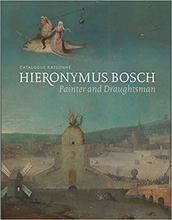More about The Conjurer
- All
- Info
- Shop

Contributor
It was a beautiful day, forty years ago, in the French commune of Saint-Germain-en-Laye when, all of a sudden, a crown jewel of the Municipal Museum, Bosch's The Conjurer, went missing, stolen by an attention-seeking group of ne'er-do-wells.
The owner's name for this work is L'Escamoteur, which means the juggler, the sorcerer, or the trickster who cleverly steals. It's derived from a French verb which means something like "to snatch" or "to make disappear." These thieves clearly had a sense of humor. Journalists took advantage of the cosmic irony at play, and published the headline, "L'Escamoteur escamoté," "the disappearer disappears." The museum got played, just like the guy hunched over in the painting, serving as the victim of the pickpocket behind him. And this is why we can't have nice things: due to the theft, the museum closed to the public, and remains closed.
Somehow, the painting ended up in the hands of a detective, who kept it for one night before giving it back to the museum. Even though the painting was returned to the museum only two months after it was stolen, they keep this work in a safe except for occasional loans to other museums and one public show per year. It's strange this fairly unknown painting is so highy secured while works like the Mona Lisa are visible to the public, but I don't make the rules.
This work's identity is full of hidden facts and ambiguity, just like the shell game of the conjurer in the painting: there are five versions of it, and we don't know which one is the original. According to the Bosch-ologist Frédéric Elsig, Bosch's disciple, Gielis Panhedel, is the true author. (But that would diminish its value.)
Aurélien Gamboni's masterful investigation of this work, opens with a quote from Apollo Robbins, a man who once pickpocketed President Jimmy Carter's security detail: "Attention is like water. It flows. It’s liquid. You create channels to divert it, and you hope that it flows the right way." Attention is the most precious "natural resource," and The Conjurer shows how people can pollute it. The really weird thing, as Gamboni notes, is that the painting itself reproduces the effect of 'mise en abyme,' the art term for a copy of an image within itself, implying infinite repetition, in a social sense: it replicates itself, it creates uncertainty, it becomes the object of theft, it reappears, its owners have to hide it from us, and so on. As an example, Gamboni indicates that the objects on the table are in the shape of a face, mirroring the face of the man looking at them, having his wallet stolen by the man behind him. "He is hypnotized," Gamboni writes, "like Narcissus, falling into the water which bears his reflection."
The "missing piece" of this image would be the spoken word, the sales pitch, an essential part of any hypnotic technique, which the artist suggests in the specifically ritualistic thumb-and-forefinger misdirection gesture of the conjurer. Instead of ingesting a sacrament, the receiver is vomiting a frog, which, for the artist, had a Satanic connotation, like Bosch's toads and various other strange animals throughout his works. This is because the frog and toad were associated with alchemy, which was itself connected with the Tarot, of which the artist was aware. But, as with all Bosch works, there is an ambiguous and unresolved meaning: occupying the lower half of the image with the animals, the child peers up at the scene, looking thoroughly amused.
Sources
- Gamboni, Aurélien. "L’Escamoteur : économie de l’illusion, écologie de l’attention?" ag-archives.net, Apr. 2013.
- Green, Adam. "A Pickpocket's Tale." The New Yorker, Dec. 30, 2012, https://www.newyorker.com/magazine/2013/01/07/a-pickpockets-tale.
- "L'Escamoteur escamoté." france culture, Jan. 1, 2017, https://www.franceculture.fr/emissions/une-histoire-particuliere-un-rec….
- "L'Escamoteur by Jerôme Bosch." Saint-Germain-en-Laye, https://web.archive.org/web/20090925083520/http://www.ot-saintgermainen….
- Library of Congress Subject Headings, Volume 3. Washington, D.C.: Library of Congress, 1998.
- Prine, John. "Live on Tour." https://www.johnprine.com/description?albumId=53.
- Van Schoute, Roger, and Monique Verboomen. Jérôme Bosch. Paris: Renaissance Du Livre, 2003.
Featured Content
Here is what Wikipedia says about The Conjurer (painting)
The Conjurer is a painting by Early Netherlandish painter Hieronymus Bosch or his workshop, executed around 1502.
There are five versions of this painting and one engraving, but most experts believe the most reliable copy is part of the collection of the Musée Municipal in Saint-Germain-en-Laye, which is kept locked in a safe and loaned out on a limited basis for special exhibitions in France and abroad. On 1 December 1978 the painting was stolen from the museum and returned on 2 February 1979.
The painting comes from the bequest of Louis Alexandre Ducastel, a notary in Saint-Germain-en-Laye from 1813, who was also city council member and mayor in August 1835 and (provisionally) in 1839. The collection seems especially to have been formed by his father John Alexander Ducastel, a painter and collector.
Check out the full Wikipedia article about The Conjurer (painting)
















